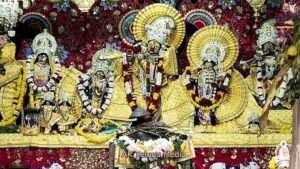 His fame spreads
His fame spreads
Attracted by the fame of Jiva Gosvami that spread more and more throughout India, in the year 1570 Emperor Akbar went to Vrindavana to meet him. Having been speechless before such wisdom and holiness, he gave his unconditional support to him and to all the Vaishnavas of Vrindavana. Thanks to the means that Akbar made available to him, the excavation and construction works gained great momentum.
Gosvami Prabhupada led his men in building the four main and oldest temples in the area: Madana-Mohana, Govindadev, Gopinath and Jugala-kisore. It is also said that at that time Sri Jiva met other famous people of the Vaishnava world, such as the poet Mirabai, but there is no evidence to prove this fact.
The temple of Radha-Damodara
However, much is known about the construction of the Radha-Damodara temple. The land where the majestic building stands today was bought by a wealthy servant of Akbar, named Alisa Chaudhari, who had been left there by the emperor with the specific task of assisting Jiva Gosvami in spreading Vaishnavism.
As soon as the land was purchased, he installed and began to faithfully serve a pair of deities of Radha and Krishna that Rupa Gosvami had given him. Even before the temple was erected, Sri Jiva had a large library (grantha-bandhara) built where the sacred scriptures would be kept. In his will (Sankalpa-patra) there is a particular reference to the preservation of books, to which he attributed exceptional importance.
In the building of the Radha-Damodara Temple a few centuries later, our revered Srila Prabhupada, Bhaktivedanta Swami, stayed in two rooms located in the cloister of the temple. There, while from the window of his room he could see the samadhis of Srila Rupa Gosvami and Sri Jiva Gosvami, he wrote the first three volumes of Srimad-Bhagavatam which today are our most precious treasure. From that room began the Krishna consciousness movement, now known throughout the world. The six Gosvamis met there often.
This is a section of the book “Tattva Sandarbha”, in English.
To buy the complete book, click here



Leave a Reply